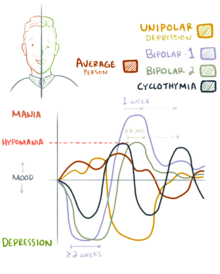Outline of bipolar disorder
The following outline is provided as an overview of and topical guide to bipolar disorder:
Bipolar disorder – mental disorder with periods of depression and periods of elevated mood.[1] The elevated mood is significant and is known as mania or hypomania, depending on its severity, or whether symptoms of psychosis are present. During mania, an individual behaves or feels abnormally energetic, happy, or irritable.[1] Individuals often make poorly thought out decisions with little regard to the consequences. The need for sleep is usually reduced during manic phases. During periods of depression, there may be crying, a negative outlook on life, and poor eye contact with others.[1] The risk of suicide among those with the illness is high at greater than 6 percent over 20 years, while self-harm occurs in 30–40 percent.[1] Other mental health issues such as anxiety disorders and substance use disorder are commonly associated. Also known as manic depression.
What type of thing is bipolar disorder?[]

Bipolar disorder can be described as all of the following:
- Disorder –
- Mental disorder – functional abnormality or disturbance characterized by a behavioral or mental pattern that may cause suffering or a poor ability to function in life. Such features may be persistent, relapsing and remitting, or occur as a single episode.
Bipolar spectrum[]
- Bipolar I – bipolar disorder with at least one manic episode (with or without psychosis), possibly with hypomanic and/or depressive episodes as well
- Bipolar II – bipolar disorder with at least one depressive and at least one hypomanic episode, without any full mania
- Cyclothymia – "mild" bipolar disorder, with symptoms of hypomania and depression not severe enough to be classified as bipolar I or II
- Dysthymia – akin to depression, with symptoms that are long-lasting but less severe
- Major depressive disorder – a mood disorder involving low mood, low energy, poor self-esteem, lack of interest in enjoyable activities, and/or aches and pains
- Schizoaffective disorder – mood swings combined with psychosis; has subtypes bipolar type and depressive type
- Mania – a state of hyperactivity, heightened mood (euphoric or irritable), low sleep, pressured speech, grandiosity, and/or racing thoughts; may include psychotic features like delusions or hallucinations
- Mixed affective state – a state with traits of both mania and depression (e.g. irritability, low mood, suicidality, and racing thoughts at the same time)
- Hypomania – a state of high mood similar to that of mania but less severe
- Major depressive episode – an episode with signs of major depressive disorder
Symptoms of bipolar disorder[]
- Anxiety – a state of increased stress and worry
- Emotional dysregulation – difficulty regulating one's mood, resulting in mood swings
- Sleep disorder – disordered sleeping habits
Signs typical of mania[]
- Delusion – fixed belief that cannot be changed despite reason or evidence, not explained by common cultural beliefs
- Hallucination – perceiving something that is not actually present
- Insomnia – difficulty falling and/or staying asleep
- Pressured speech – rapid, erratic, and/or frenzied speech that can be difficult for others to understand and interrupt
- Psychosis – inability to distinguish between reality and fantasy
- Racing thoughts – rapid thinking, sometimes experienced as distracting or distressing
Signs typical of depression[]
- Anhedonia – reduced ability to experience pleasure
- Dysphoria – a state of profound unhappiness or discomfort
- Hypersomnia – excessive sleeping and/or sleepiness
- Self harm – causing intentional pain or injury to the body, often as self-punishment or emotional release
- Suicidal ideation – considering committing suicide
Treatment of bipolar disorder[]

- Treatment of bipolar disorder –
- Treatment of bipolar disorder – Mood stabilizers – medication that reduces mood swings and allows the user to experience a more typical range of moods
- Anticonvulsants –
- Carbamazepine –
- Gabapentin –
- Lamotrigine (Lamictal) –
- Oxcarbazepine –
- Topiramate –
- Valproic acid –
- Sodium valproate –
- Valproate semisodium –
- Lithium pharmacology –
- Lithium carbonate –
- Lithium citrate –
- Lithium sulfate –
- Antipsychotics –
- Treatment of bipolar disorder – Anxiety –
- Alprazolam (Solanax and Xanax) –
- List of benzodiazepines –
Non-pharmaceutical treatment of bipolar disorder[]
- Clinical psychology –
- Electroconvulsive therapy –
- Involuntary commitment –
- Light therapy –
- Psychotherapy –
- Transcranial magnetic stimulation –
History of bipolar disorder[]
- Emil Kraepelin –
- Karl Leonhard –
- John Cade –
- Mogens Schou –
- Frederick K. Goodwin –
- Kay Redfield Jamison –
Organisations[]
See also[]
- Affective spectrum – spectrum of mood disorders, including disorders that impact other areas in addition to mood (e.g. ADHD and migraines)
- List of people with bipolar disorder –
- Bipolar disorder in children – pediatric bipolar disorder, which sometimes involves more rapid shifting and mixed states
References[]
- ^ Jump up to: a b c d Anderson IM, Haddad PM, Scott J (Dec 27, 2012). "Bipolar disorder". BMJ (Clinical Research Ed.). 345: e8508. doi:10.1136/bmj.e8508. PMID 23271744. S2CID 22156246.
External links[]
- Bipolar Disorder overview from the U.S. National Institute of Mental Health website
- NICE Bipolar Disorder clinical guidelines from the U.K. National Institute for Health and Clinical Excellence website
- Bipolar disorder
- Outlines of health and fitness
- Wikipedia outlines